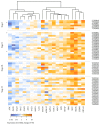The Dysregulation of Polyamine Metabolism in Colorectal Cancer Is Associated with Overexpression of c-Myc and C/EBPβ rather than Enterotoxigenic Bacteroides fragilis Infection
- PMID: 27433286
- PMCID: PMC4940579
- DOI: 10.1155/2016/2353560
The Dysregulation of Polyamine Metabolism in Colorectal Cancer Is Associated with Overexpression of c-Myc and C/EBPβ rather than Enterotoxigenic Bacteroides fragilis Infection
Abstract
Colorectal cancer is one of the most common cancers in the world. It is well known that the chronic inflammation can promote the progression of colorectal cancer (CRC). Recently, a number of studies revealed a potential association between colorectal inflammation, cancer progression, and infection caused by enterotoxigenic Bacteroides fragilis (ETBF). Bacterial enterotoxin activates spermine oxidase (SMO), which produces spermidine and H2O2 as byproducts of polyamine catabolism, which, in turn, enhances inflammation and tissue injury. Using qPCR analysis, we estimated the expression of SMOX gene and ETBF colonization in CRC patients. We found no statistically significant associations between them. Then we selected genes involved in polyamine metabolism, metabolic reprogramming, and inflammation regulation and estimated their expression in CRC. We observed overexpression of SMOX, ODC1, SRM, SMS, MTAP, c-Myc, C/EBPβ (CREBP), and other genes. We found that two mediators of metabolic reprogramming, inflammation, and cell proliferation c-Myc and C/EBPβ may serve as regulators of polyamine metabolism genes (SMOX, AZIN1, MTAP, SRM, ODC1, AMD1, and AGMAT) as they are overexpressed in tumors, have binding site according to ENCODE ChIP-Seq data, and demonstrate strong coexpression with their targets. Thus, increased polyamine metabolism in CRC could be driven by c-Myc and C/EBPβ rather than ETBF infection.
Figures




Similar articles
-
Screening for enterotoxigenic Bacteroides fragilis in stool samples.Anaerobe. 2016 Aug;40:50-3. doi: 10.1016/j.anaerobe.2016.05.004. Epub 2016 May 7. Anaerobe. 2016. PMID: 27166180
-
Polyamine catabolism contributes to enterotoxigenic Bacteroides fragilis-induced colon tumorigenesis.Proc Natl Acad Sci U S A. 2011 Sep 13;108(37):15354-9. doi: 10.1073/pnas.1010203108. Epub 2011 Aug 29. Proc Natl Acad Sci U S A. 2011. PMID: 21876161 Free PMC article.
-
The association between fecal enterotoxigenic B. fragilis with colorectal cancer.BMC Cancer. 2019 Sep 5;19(1):879. doi: 10.1186/s12885-019-6115-1. BMC Cancer. 2019. PMID: 31488085 Free PMC article.
-
Prevalence of enterotoxigenic Bacteroides fragilis in patients with colorectal cancer: a systematic review and meta-analysis.Front Cell Infect Microbiol. 2025 Mar 7;15:1525609. doi: 10.3389/fcimb.2025.1525609. eCollection 2025. Front Cell Infect Microbiol. 2025. PMID: 40125515 Free PMC article.
-
A systemic review of the role of enterotoxic Bacteroides fragilis in colorectal cancer.Neoplasia. 2022 Jul;29:100797. doi: 10.1016/j.neo.2022.100797. Epub 2022 Apr 20. Neoplasia. 2022. PMID: 35461079 Free PMC article.
Cited by
-
Antizyme inhibitor family: biological and translational research implications.Cell Commun Signal. 2024 Jan 2;22(1):11. doi: 10.1186/s12964-023-01445-1. Cell Commun Signal. 2024. PMID: 38169396 Free PMC article. Review.
-
Structure of human spermine oxidase in complex with a highly selective allosteric inhibitor.Commun Biol. 2022 Aug 5;5(1):787. doi: 10.1038/s42003-022-03735-9. Commun Biol. 2022. PMID: 35931745 Free PMC article.
-
Mutational load in carotid body tumor.BMC Med Genomics. 2019 Mar 13;12(Suppl 2):39. doi: 10.1186/s12920-019-0483-x. BMC Med Genomics. 2019. PMID: 30871634 Free PMC article.
-
Polyamine Metabolism and Oxidative Protein Folding in the ER as ROS-Producing Systems Neglected in Virology.Int J Mol Sci. 2018 Apr 17;19(4):1219. doi: 10.3390/ijms19041219. Int J Mol Sci. 2018. PMID: 29673197 Free PMC article. Review.
-
Enhancing the radiosensitivity of colorectal cancer cells by reducing spermine synthase through promoting autophagy and DNA damage.World J Gastrointest Oncol. 2024 Dec 15;16(12):4716-4727. doi: 10.4251/wjgo.v16.i12.4716. World J Gastrointest Oncol. 2024. PMID: 39678812 Free PMC article. Review.
References
-
- Kohler B. A., Sherman R. L., Howlader N., et al. Annual report to the nation on the status of cancer, 1975–2011, featuring incidence of breast cancer subtypes by race/ethnicity, poverty, and state. Journal of the National Cancer Institute. 2015;107(6) doi: 10.1093/jnci/djv048.djv048 - DOI - PMC - PubMed
MeSH terms
Substances
LinkOut - more resources
Full Text Sources
Other Literature Sources
Medical
Research Materials
Miscellaneous

